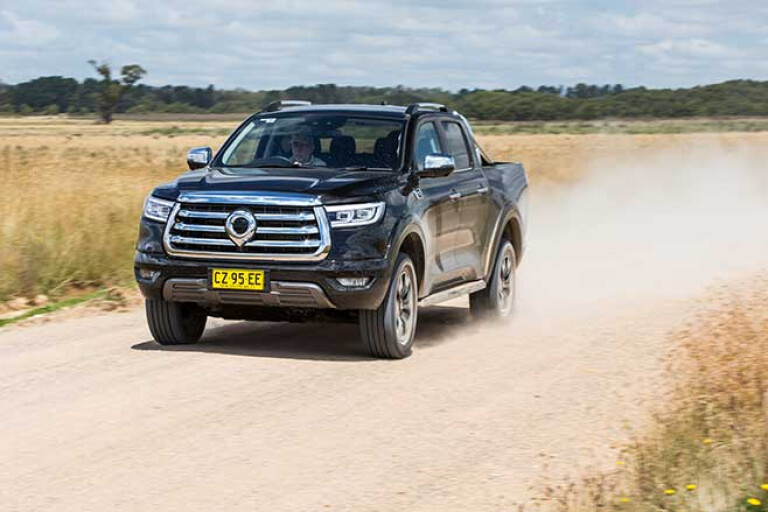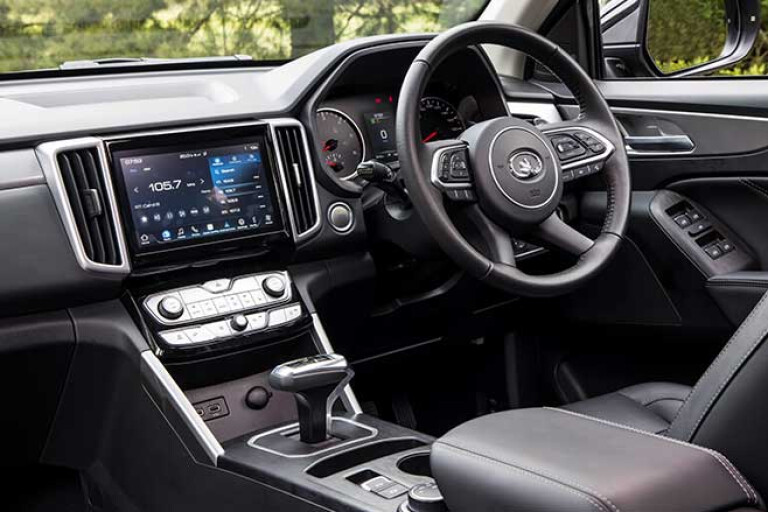
GWM stands for Great Wall Motors and is effectively a renaming of what was previously Great Wall, a brand that’s now reasonably familiar in Australia having been here since 2009. GWM is China’s largest ute, 4x4 and SUV maker, examples of the latter two being sold here under the Havel brand.
The new GWM Ute is presented as the Cannon, Cannon-L (as tested here) and the Cannon-X, with prices starting at a low $33,990, which includes government and dealer charges.
The Ute is effectively new from the ground up, although it does use a revised version of the 2.0-litre diesel engine from the previous Great Wall Steed, although now backed exclusively by an eight-speed automatic gearbox rather than a six-speed manual, the only gearbox offered with the Steed.
Most notably the GWM Ute is much bigger than the Steed and gives nothing away in size to the biggest utes in the class such as the Ford Ranger, whereas the Steed was a small ute by current standards. And where the Steed was behind the game in terms of technology and sophistication, the new GWM Ute comes stacked with the latest safety and convenience kit.
POWERTRAIN AND PERFORMANCE
THANKS to a new turbo and a more sophisticated (read higher pressure) diesel injection system – the usual ‘tune-up’ items with modern turbo diesels – what was 110kW and 310Nm in the Steed has become 120kW and 400Nm in the GWM Ute.
Complete with the now obligatory diesel particulate filter (DPF) the engine meets the now mandatory in Australia Euro 5 emissions standards. A manual DPF regeneration switch is provided, which is a very practical touch. Sold elsewhere (with the addition of urea injection or AdBlue) it’s a Euro 6 engine, which is testament to its modernity of its top-end remake.

On the road 120kW and 400Nm still doesn’t set the world on fire, as you would expect, but the engine still gets along effortlessly enough in general give-and-take driving, doesn’t make a fuss on hills and all the while, is relatively smooth, refined and quiet. However a colleague drove a different example and complained of excessive vibration at urban speeds, something not evident with the example tested here.
Helping getting the most out of this engine revision is a slick eight-speed automatic, made under licence from German transmission specialist ZF. As ever with the now ubiquitous ZF eight-speed the shifts are near seamless, especially with moderate throttle loads.
The shifts are also well-timed which, along with the relatively gear close ratios, helps keep things percolating along nicely. Paddle shifts are also provided for the ‘manual’ control if you so wish, and most useful off road.
Not so good is the throttle progression, which is soft in initial response but then ramps up quickly. You get used to it, but it could and should be better. The overall throttle travel is too short too, especially for off-road driving.
ON-ROAD RIDE AND HANDLING
THE Ute’s chassis is a world apart from the Steed. Gone is the latter’s torsion bar front suspension and hydraulically assisted recirculating-ball steering. In its place the Ute has far more sophisticated double-wishbone coil-spring front suspension and electric power steering. A live axle and leaf springs are of course retained at the rear, as are disc brakes, an unusual feature in this class.
Unladen, the Ute’s ride is firm as you would expect, but the general handling is tidy enough even on bumpier roads. The damping seems well-sorted, and likewise the suspension’s front-to-rear match is good.
The electric power steering means that little steering effort is needed at parking speeds, but at highway speeds the steering is too heavy and notably devoid of feel. Like the throttle, you get used to it, but it’s not something you learn to love.

More positive is the on-demand 4x4 system, which means drive to all four wheels is engaged if any when needed. Presumably it’s the same or similar made-under-licence Borg Warner system used in the Steed and likewise similar to that used in the Ford Everest.
It does its best work on wet bitumen or on roads that alternate between sealed and unsealed and is a significant step up from the relatively primitive part-time 4x4 systems used in most of the mainstream popular utes. It provides ‘Normal’, ‘Sport’ and ‘Eco’ driving modes via a rotary dial on the centre console.
In what is becoming a now recurring theme in new cars thus equipped, some of the high-tech safety aids are more annoying than helpful. In particular the active lane-keeping assistance can at times try to counter your steering input without good reason. Winding country roads are a particular problem.
You can go into a readily accessible menu to switch off the lane keeping, but it defaults to the on position every time you switch the ignition off and then on again.
OFF-ROAD
THE same dial is used to engage low range, which offers a good reduction especially given the eight-speed auto has an especially low first gear anyway.
The Ute also offers respectable ground clearance and notably good rear wheel travel to provide class-competitive off-road ability. A driver-switched rear locker is also standard and when engaged, it doesn’t appear to kill the ETC across the front axle, which is a major positive.

A reasonably solid looking front skid plate, and front and rear recovery hooks are other positives. Likewise the engine draws its air through the inner guard, which should help with water crossings.
The standard road-pattern tyres don’t help off road but are in the common 265/60R18 size, which is both taller and wider than the tyres used on the Steed and means plenty of options for replacement rubber.
CABIN AND ACCOMMODATION
THE GWM cabin presents as modern but glitzy, but is also roomy and decently finished. Keyless entry and push-button start continues the modern theme but the tilt-only steering wheel reach adjustment in this mid-spec model (as well as the base model) seems like penny-pinching given the top-spec model gets both tilt and reach adjustment.

No entry-assist handle for the driver (passenger only) is another omission. Otherwise the driving position works well in terms of vision and general comfort, and shorter drivers will appreciate the good amount of height adjustment with the seat. Rear seat room is also good and up with the bigger utes in the class.
PRACTICALITIES
THE Ute is rated to tow 3000kg, so a little below the class norm but with only 120kW on offer, 3000kg might even be a bit of a stretch under more demanding conditions.
An assisted tailgate is easy to open and close and while four tie-downs are provided, unfortunately the front two are mounted too high, as is the norm on most utes. There’s also not sufficient room between the wheel arches for a full-size pallet, again an unfortunate norm for most utes, VW’s Amarok being the notable exception.
To sweeten what is already an attractive deal price-wise, GWM offers fixed price servicing for the Ute for the annual and/or 10,000km services pegged at $360 for the first five dealer visits.
SUMMING UP
THE GWM Ute is a huge step forward from the Steed and presents a compelling argument for the price. It will be best as an everyday family ute with some weekend 4x4 recreation thrown in, but can do work duties as well as long as that doesn’t involve heavy-duty towing.
As a day-to-day ute it certainly ticks all the main boxes, even if it needs a little more finesse at the driver interface to keep keen drivers happy.
WHAT YOU GET
THE GWM Ute comes in three specification levels and is stacked with kit from the bottom up. Standard across the full range, which starts at $33,990 (driveaway) for the Cannon, is a full suite of safety features led by automatic emergency braking, lane-keeping assistance, radar cruise control, rear cross-traffic alert, tyre-pressure monitoring, over-speed warning, rear and kerbside cameras, and seven cabin airbags.
Keyless entry, push-button start, auto on/off LED headlights, a 9-inch touchscreen and the usual smartphone connectivity apps are also standard across the range. Mechanically all models also get the same engine, the same eight-speed automatic, the same on-demand 4x4 system, a rear differential lock and 18-inch wheels. All models also get side-steps.

The $37,990 (driveaway) Cannon-L (as tested here) then adds heated front seats, electric seat adjustment for the driver, automatic climate control, a 360⁰-view camera, a 220V power outlet, sports bar, tub liner, easy up/down tailgate, lots of chrome and other minor items.
The top-spec $40,990 (driveaway) Cannon-X then adds leather, reach (as well as tilt) steering-wheel adjustment, electric adjust for the passenger seat, wireless phone charging and different ‘modes’ for the electric power steering as its main attractions.
GWM UTE CANNON-L SPECS
ENGINE: 2.0-litre 4-cyl turbo diesel
MAX POWER: 120kW at 3600rpm
MAX TORQUE: 400Nm at 1500 to 2500rpm
GEARBOX: Eight-speed automatic
4X4 SYSTEM: Dual-range on-demand
CRAWL RATIO: N/A
CONSTRUCTION: Separate chassis
FRONT SUSPENSION: Independent/coil springs
REAR SUSPENSION: Live axle/leaf springs
WHEEL/TYRE: 265/60R18 110H
FUEL TANK CAPACITY: 78L
ADR FUEL USE: 9.4L/100km
TEST FUEL USE: 10.8L/100km
DEPARTURE ANGLE: 25⁰
RAMPOVER ANGLE: 21.1⁰
APPROACH ANGLE: 27⁰
GROUND CLEARANCE: 194mm (laden)

COMMENTS